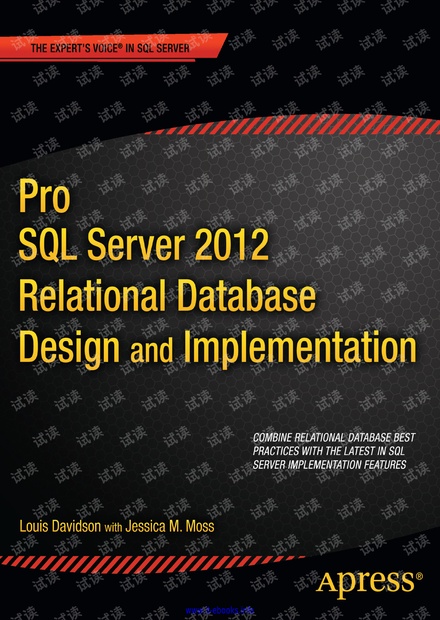没有合适的资源?快使用搜索试试~ 我知道了~
首页Pro SQL Server 2012 Relational Database Design and Implementation(Apress,2012)
Learn effective and scalable database design techniques in a SQL Server environment. Pro SQL Server 2012 Relational Database Design and Implementation covers everything from design logic that business users will understand, all the way to the physical implementation of design in a SQL Server database. Grounded in best practices and a solid understanding of the underlying theory, Louis Davidson shows how to "get it right" in SQL Server database design and lay a solid groundwork for the future use of valuable business data.
资源详情
资源评论
资源推荐

v
Contents at a Glance
Foreword .....................................................................................................................xix
About the Author
....................................................................................................... xxi
About the Technical Reviewer
................................................................................... xxiii
Acknowledgments
...................................................................................................... xxv
Introduction
.............................................................................................................. xxvii
Chapter 1: The Fundamentals
■ ......................................................................................1
Chapter 2: Introduction to Requirements
■ ..................................................................37
Chapter 3: The Language of Data Modeling
■ ...............................................................53
Chapter 4: Initial Data Model Production
■ ..................................................................91
Chapter 5: Normalization
■ .........................................................................................129
Chapter 6: Physical Model Implementation Case Study
■ ..........................................169
Chapter 7: Data Protection with Check Constraints and Triggers
■ ...........................245
Chapter 8: Patterns and Anti-Patterns
■ ....................................................................301
Chapter 9: Database Security and Security Patterns
■ ..............................................371
Chapter 10: Table Structures and Indexing
■ .............................................................445
Chapter 11: Coding for Concurrency
■ .......................................................................505
Chapter 12: Reusable Standard Database Components
■ ..........................................563
www.it-ebooks.info

■ Contents at a GlanCe
vi
Chapter 13: Considering Data Access Strategies ■ ....................................................595
Chapter 14: Reporting Design
■ ..................................................................................639
Appendix A
■ ..............................................................................................................671
Appendix B
■ ..............................................................................................................707
Index
...........................................................................................................................735
www.it-ebooks.info

xxvii
Introduction
I often ask myself, “Why do I do this? Why am I writing another edition of this book? Is it worth it? Isn’t there
anything else that I could be doing that would be more beneficial to me, my family, or the human race? Well, of
course there is. e fact is, however, I generally love relational databases, I love to write, and I want to help other
people get better at what they do.
When I was first getting started designing databases, I learned from a few great mentors, but as I wanted to
progress, I started looking for material on database design, and there wasn’t much around. e best book I found
was an edition of Chris Date’s An Introduction to Database Systems (Addison Wesley, 2003), and I read as much
as I could comprehend. e problem, however, was that I quickly got lost and started getting frustrated that I
couldn’t readily translate the theory of it all into a design process that really seems quite simple once you get
down to it. I really didn’t get it until I had spent years designing databases, failing over and over until I finally saw
the simplicity of it all. In Chris’s book, as well as other textbooks I had used, it was clear that a lot of theory, and
even more math, went into creating the relational model.
If you want a deep understanding or relational theory, Chris’s book is essential reading, along with lots
of other books (Database Debunkings, www.dbdebunk.com/books.html, is a good place to start looking for
more titles). e problem is that most of these books have far more theory than the average practitioner wants
(or will take the time to read), and they don’t really get into the actual implementation on an actual database
system. My book’s goal is simply to fill that void and bridge the gap between academic textbooks and the purely
implementation-oriented books that are commonly written on SQL Server. My intention is not to knock those
books, not at all—I have numerous versions of those types of books on my shelf. is book is more of a technique-
oriented book than a how-to book teaching you the features of SQL Server. I will cover many the most typical
features of the relational engine, giving you techniques to work with. I can’t, however, promise that this will be the
only book you need on your shelf.
If you have previous editions of this book, you might question why you need this next edition, and I ask
myself that every time I sit down to work on the next edition. You might guess that the best reason is that I cover
the new SQL Server 2012 features. Clearly that is a part of it, but the base features in the relational engine that
you need to know to design and implement most databases is not changing tremendously over time. Under
the covers, the engine has taken more leaps, and hardware has continued up and up as the years progress. e
biggest changes to SQL Server 2012 for the relational programmer lie in some of the T-SQL language features, like
windowing functions that come heavily into play for the programmer that will interact with your freshly designed
and loaded databases.
No, the best reason to buy the latest version of the book is that I continue to work hard to come up with new
content to make your job easier. I’ve reworked the chapter on normalization to be easier to understand, added
quite a few more patterns of development to Chapter 7, included a walkthrough of the development process
(including testing) in Chapter 6, some discussion about the dierent add-ins you can use to enhance your
databases, and generally attempted to improve the entire book throughout to be more concise (without losing the
folksy charm, naturally). Finally, I added a chapter about data warehousing, written by a great friend and fellow
MVP Jessica Moss.
www.it-ebooks.info
剩余766页未读,继续阅读
vanridin
- 粉丝: 108
- 资源: 1192
上传资源 快速赚钱
 我的内容管理
收起
我的内容管理
收起
 我的资源
快来上传第一个资源
我的资源
快来上传第一个资源
 我的收益 登录查看自己的收益
我的收益 登录查看自己的收益 我的积分
登录查看自己的积分
我的积分
登录查看自己的积分
 我的C币
登录后查看C币余额
我的C币
登录后查看C币余额
 我的收藏
我的收藏  我的下载
我的下载  下载帮助
下载帮助

会员权益专享
最新资源
- RTL8188FU-Linux-v5.7.4.2-36687.20200602.tar(20765).gz
- c++校园超市商品信息管理系统课程设计说明书(含源代码) (2).pdf
- 建筑供配电系统相关课件.pptx
- 企业管理规章制度及管理模式.doc
- vb打开摄像头.doc
- 云计算-可信计算中认证协议改进方案.pdf
- [详细完整版]单片机编程4.ppt
- c语言常用算法.pdf
- c++经典程序代码大全.pdf
- 单片机数字时钟资料.doc
- 11项目管理前沿1.0.pptx
- 基于ssm的“魅力”繁峙宣传网站的设计与实现论文.doc
- 智慧交通综合解决方案.pptx
- 建筑防潮设计-PowerPointPresentati.pptx
- SPC统计过程控制程序.pptx
- SPC统计方法基础知识.pptx
资源上传下载、课程学习等过程中有任何疑问或建议,欢迎提出宝贵意见哦~我们会及时处理!
点击此处反馈



安全验证
文档复制为VIP权益,开通VIP直接复制
 信息提交成功
信息提交成功


评论0